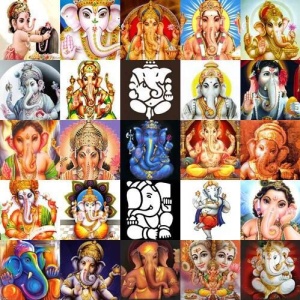I find the concept of imaginary childhood friends fascinating. I love reading about them. The need for creating a fictional character with whom you can have lengthy conversations and special experiences enthralls me. It points to the fact that human beings occasionally need to use their imagination to fill in a void they may have in their lives.
Or, because they have a vision of their world that cannot be limited to material realities.
This is how I felt about my friend too. Of course he was not imaginary.
He was just not physically visible by all.
I became friends with him when my mother first told me his story. It captivated me. It still does. Of course, the reasons I love him now have changed. Now, I see the symbolism behind every nuance of his story. Then, I simply saw his beautiful elephant head, his round little belly and the naughty smile on his face. His name is Ganesha. He is a Hindu god. And this is his story.
Once upon a very long time ago the great god Shiva had to leave his home in Mount Kailash (which is in the Himalayas). He left his wife Parvati at home. Now, Parvati was no ordinary woman. How could she be? She was married to Shiva, the god of destruction, after all. She was a very powerful goddess in her own right. But Parvati got lonely without Shiva and decided to create a little boy out of clay to keep her company. The statue was beautiful and with her magical powers she brought it to life. Since she had created him she called him her son. She named him Ganesha.
One day Parvati went to bathe and told her son to stand guard at the door. Shiva returned and demanded to enter. Ganesha would not let him in. Shiva is really not someone you want to mess around with. Like I said, he is the Hindu god of destruction! So, Shiva took his sword and cut off Ganesha’s head. When Parvati saw what Shiva had done she was distraught. (And we all know that an unhappy wife can be an extremely unpleasant experience.)
Even for a god.
Shiva promised her that he would fix this. He told his army to bring the first head that they could find of a living creature back to him. The head they brought back was of a baby elephant. Shiva promptly placed this on Ganesha’s body. And voila, he was whole again!
Shiva turned proudly to Parvati. But she was wailing even louder this time. ‘Who will care for my son now that you have made him look like this? He is neither human nor animal!”
So Shiva declared that prayers must be offered to Ganesha before any other god. A decree that many Hindus honor to this day.
Now, let me just say that this is simply one version of this story. The version I learned when I was a young girl. The version that made me fall in love with Ganesha. The version that made him my childhood friend.
I mean, how cool is that? I had a cute elephant-headed god as my buddy. And, oh how I loved him!
Naturally, as I grew older I learned the symbolism behind this story. (Don’t worry, it didn’t make him any less cool.)
I learned that his elephant head symbolizes that he can remove any obstacle in his way with his trunk. This is why it is useful to pray to him before starting any new venture.
I learned that his big ears symbolize the importance of being someone who listens more and talks less. These large ears allow Ganesha to listen to the requests of all his devotees.
I learned that his large tummy symbolizes his ability to take in all that life has to offer. To digest our pain and sorrow while reveling in our joys and triumphs.
I learned that the broken tusk in his hand symbolizes sacrifice since he broke it off to use as a pen to write the Hindu epic The Mahabharata. A sacrifice that allows us to continue to learn from this sacred scripture.
As I grow older I have learned to value these stories even more. I have learned that I am fortunate to have had such a powerful childhood friend. I have learned that his ability to make me laugh and smile was truly a gift from the gods. And that the best way for me to return the love he showered on me is by making sure he is honored as the mighty indomitable elephant god that he is.


The side pose of Ganesha looks like aum as written in the Indian script. And that is the word we believe is with God and is God!
That’s a great point- must remember that 🙂
I have always been very drawn to Ganesh (as a non-Hindu) and I love this story. Now I will have to share it with my son.
I am so glad the story resonated with you. I hope your son enjoys it too 🙂
Maaaaast!!!
Loved it!!
You know Nandini , I don’t know if I have told you but even me , my Favourite God!! Makes me smile every time I look at him:)
Very nicely portrayed!!
Loved it!!
Thanks Nikki- I’m glad you enjoyed it- he is a real sweetheart 🙂
This is beautiful! Such wisdom a child’s mind has, perhaps from some previous experience, our species tends to forget the ability to commune with the world and God all around us.
Thank you for your kind words. I’m glad the story resonated with you 🙂